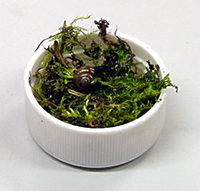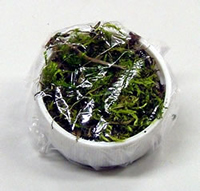Posting specimens
A reliable method for sending live insects through the post in standard sized envelopes.
by A.C. Harris, Otago Museum, Dunedin.
 Museum entomologists often receive letters requesting the identification of an insect, the remains of which are spread out on the letter like a Rorschach blot. Consequently, for many years I have requested that members of the public post me specimens by the following method, which is invariably reliable. The insects have always arrived live and in good condition, if the instructions have been followed.
Museum entomologists often receive letters requesting the identification of an insect, the remains of which are spread out on the letter like a Rorschach blot. Consequently, for many years I have requested that members of the public post me specimens by the following method, which is invariably reliable. The insects have always arrived live and in good condition, if the instructions have been followed.
A small metal or plastic lid, 5-6 mm deep and 15-20 mm in diameter, is used. Such lids can be obtained from pill vials or similar bottles. An alternative is to cut down a small vial made from soft plastic and use only the bottom 5-6 mm. [Obviously, if the insect is larger than this, then a large lid will beed to be used. Keep in mind that the NZ Post maximum thickness for an envelope is 20mm.]
A piece of gladwrap or clear plastic from a plastic bag, is cut to a disc about twice the diameter of the lid.
Next, some live, green, fresh Sphagnum, or similar moss, is obtained, perhaps under and among grass in a shaded part of a backyard lawn. In the inside of the lid a sufficient quantity of moss is placed to fill it almost completely, but the moss must not be compressed. A small cavity is made gently in the moss in the lid, the insect is placed carefully in the cavity, and a final fragment of moss is positioned gently over it.
 The gladwrap or plastic disc is then placed over the open side of the lid, and folded down around the closed side underneath. A square of Sellotape is attached to the base, and two further strips wrapped over the lid in two directions, forming a cross on the top and the bottom.
The gladwrap or plastic disc is then placed over the open side of the lid, and folded down around the closed side underneath. A square of Sellotape is attached to the base, and two further strips wrapped over the lid in two directions, forming a cross on the top and the bottom.
The package is held firmly within the envelope so that it will not move, by lightly sellotaping it face-down to a small plain sheet of note paper or card. This is folded and put into the envelope, positioned so that the lid is in the end furthest from the stamp.
The metal or plastic lid effectively shields the insect, preventing it from being squashed; the moss secures the specimen and prevents it from rattling around while also providing oxygen and moisture. The gladwrap retains the moisture so that the specimen does not dies from desiccation.
 The specimen will last for several days, but should always be sent by 'fastpost' or 'airmail'.
The specimen will last for several days, but should always be sent by 'fastpost' or 'airmail'.
Reproduced with the permission of the Entomological Society of New Zealand, from The Weta - Newsbulletin of the Entomological Society of New Zealand Inc. Vol. 20 No 2, p. 32-33, Dec 1997.
